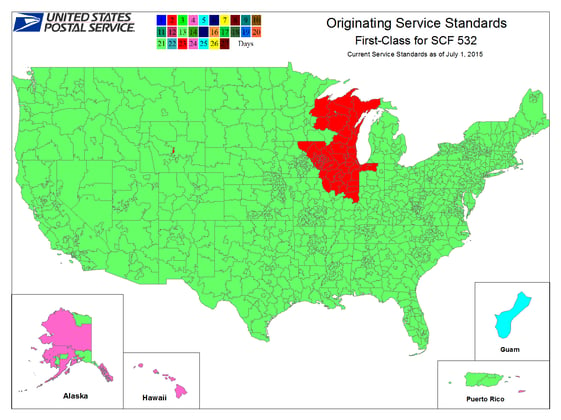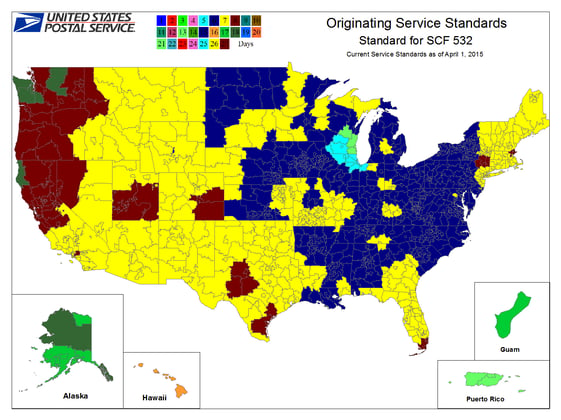Today, direct mail, or “snail mail”, is often viewed as an “old” method of contacting stakeholders, donors and voters for political, nonprofit, or fundraising purposes. If done well, direct mail is still one of the best methods to achieve a reliable response rate for direct marketing and fundraising as well as advertising  impression to communicate a message. Most marketers who shun direct mail simply do not understand the process or believe that the process takes too long, is too difficult, or too expensive of an option to pursue. Read on if you’d like to gain some insight on the direct mail process.
impression to communicate a message. Most marketers who shun direct mail simply do not understand the process or believe that the process takes too long, is too difficult, or too expensive of an option to pursue. Read on if you’d like to gain some insight on the direct mail process.
Ensuring direct mail reaches your target households on the dates you want includes more than simply printing pieces and dropping them in a blue USPS box. Campaigns and organizations that utilize direct mail need to take into account not only design and print time, but also time spent being verified and actually entering the mail stream.
Lead Time, Drop Date, and Hit Time
The whole direct mail process can be summed up in three phases, lead time, drop date, and hit date. these phases take the mail through creation and assembly at the mail house, verification and processing at the United States Postal Service (USPS), and arrival at final destination.
There are three important dates to keep in mind when sending direct mail: lead time, drop date, and hit time.
Lead time is the amount of time from printing and preparing mail pieces until the time the mail is delivered to the Business Mail Entry Unit (BMEU). Campaign Now can process direct mail orders up to 10,000 pieces in-house. It takes us approximately 8 man hours to prepare 1,000 pieces, so lead time will vary based on order size and complexity of the mail piece. After we receive all materials and are approved to begin printing, the longest lead time we require is 48 hours. From there, we go to the drop date.
Drop date is simply the time we drop the completed pieces at the BMEU for verification and processing, and from there they enter the mail stream. Verification is a relatively quick process where USPS scans the order in, weighs the mail, and preps it for processing. Processing involves verification against the standards set in the Domestic Mail Manual for discounts, sorting, barcodes and piece counts. Once a piece enters the mail stream it’s on the way to its hit date.
Hit date is the day that individual mail pieces arrive at their designated mail box. Hit Dates will vary based on mail class and proximity to the mail's originating facility.
Does Mail Postage Class Matter?
The short answer is, yes. The mail class that you choose for your direct mail pieces will affect the duration of time between the drop date and the hit date. Understanding direct postage classes will help you possibly save money and maximize the return on investment of your mailer while also achieving delivery speeds similar to First Class mail. Here are some details on various postage classes that you should know about.
First Class Mail
This is the most common postage class to send mail. It involves affixing a first class postage stamp to each piece of mail. The amount of postage depends on the package weight.
- Cost: Stamp must be adhesively applied to the envelope at the current rate of $0.49 per stamp.
- Deadline: If order is dropped at the BMEU by 6pm any business day, the mail is verified, processed, and enters the mail stream by the end of the next business day.
- Piece Minimum: None, you can drop as many or few as you like.
Presorted First Class
This postage class is similar to First Class mail, but requires a bulk mail permit to process, which is applied to the mail via printed or stamped indicia in lieu of an adhesive stamp.
- Cost: $0.47 per piece
- Deadline: Same as First Class Mail, if it is in by 6 PM it will be in the mail stream before the end of the next business day.
- Piece Minimum: There is a minimum requirement of 500 mail pieces to qualify for Presort First Class.
Map of First Class Delivery Times From Milwaukee WI.
Bulk Presort Standard Class
Presorted standard mail is slower than First Class mail, but it is also considerably cheaper. It is a good option for mail that does not need to reach destination on a tight time schedule.
- Cost: $0.31 per piece
- Deadline: Needs to be into the BMEU by 2 PM if you want to have it through verification and processing, and into the mail stream by the next business day.
- Piece Minimum: 200 pieces.
Bulk Presort Nonprofit Standard Class
Non profit standard is almost identical to Bulk Presort Standard Mail, except it is much cheaper and is only available to qualified nonprofit organizations.
- Cost: $0.18 per piece
- Deadline: Needs to be into the BMEU by 2pm if you want to have it through verification and processing, and into the mail stream by the next business day.
- Piece Minimum: 200 pieces.
- Special Notes: To qualify for nonprofit rates, an organization must have a nonprofit bulk mail permit. Also, if shipping from a new point of entry, a point of entry request must be submitted to whichever BMEU you wish to mail from.
Political Presort Standard Class, AKA “Red Tagged”
Qualified election mail is given expedited treatment by USPS, to ensure prompt delivery of time sensitive political mail.
- Cost: $0.31 per piece
- Deadline: Although after processing “Red Tagged” mail is treated like First Class Mail, it needs to be into the BMEU by 2pm if you want to have it through verification and processing, and into the mail stream by the next business day. Most BMEUs recommend this mail enter the mail stream no later than the Wednesday prior to election day in order to ensure delivery by the Monday before the election.
- Piece Minimum: 200 pieces.
- Special Notes: During processing and delivery packaging, each container of campaign mail is affixed with a red tag that reads “Political Campaign Mailing”. The tag then identifies the mail to all facilities and handlers in the mail stream that the mail is political and is essentially treated as First Class Mail. Red Tagged mail is also tracked and logged at every stage of the mail stream process. For mail to qualify as “Red Tagged” political mail, it must be a political campaign mailing from a political candidate, campaign committee, political party committee, PAC, Super-PAC, or other organization that is sending mail for issue advocacy or voter mobilization purposes.
Map of Standard Class Delivery Times From Milwaukee WI.
For more information, an interactive map of USPS Service Standards can be found here.





